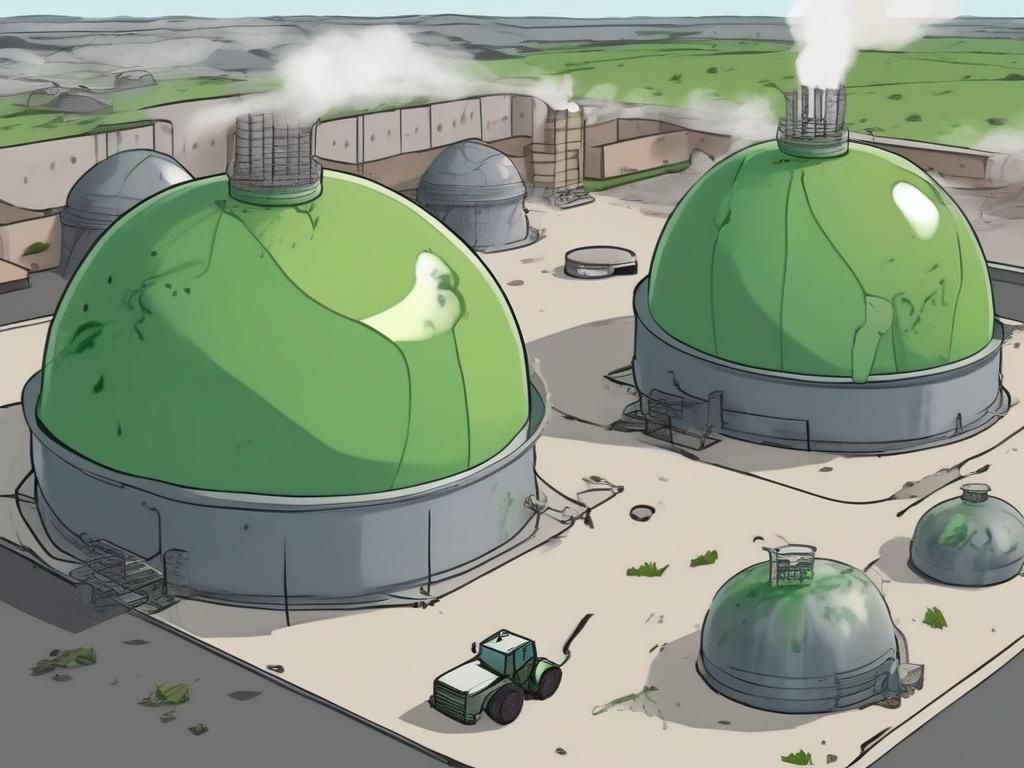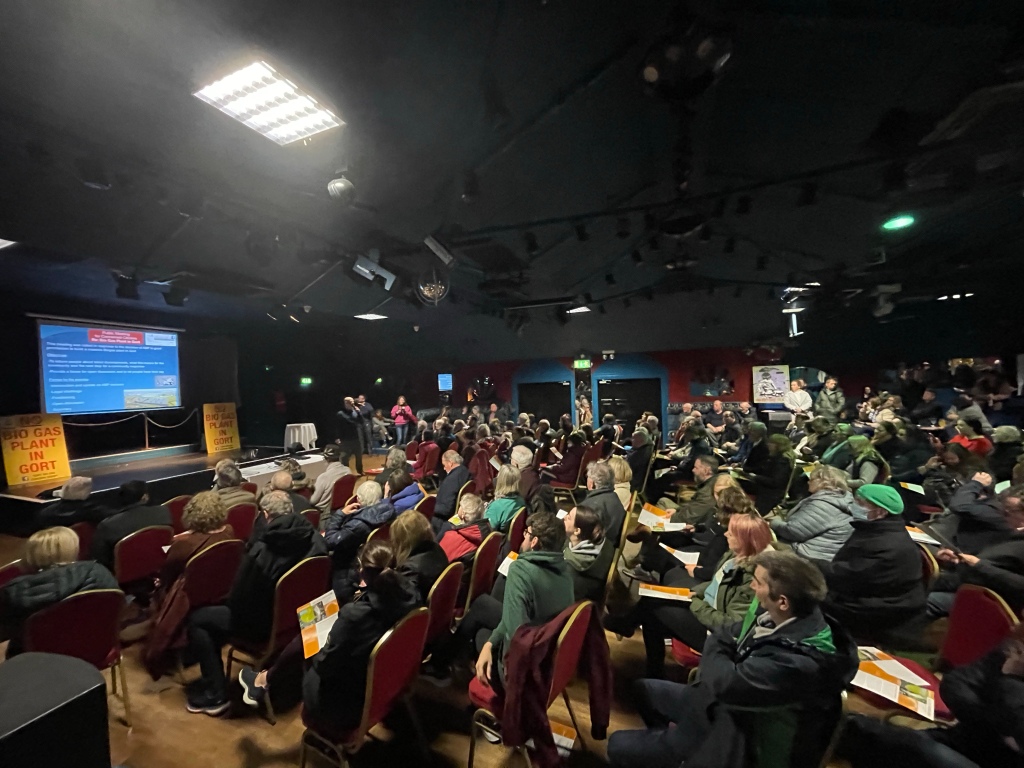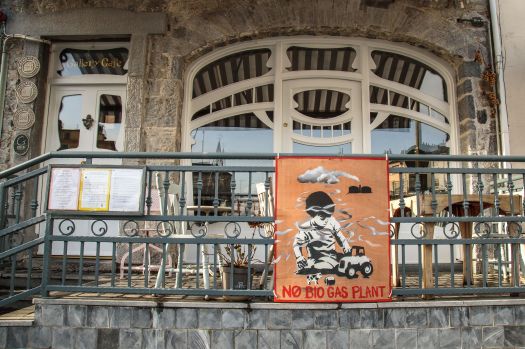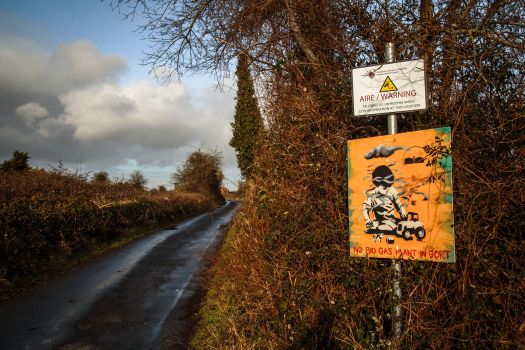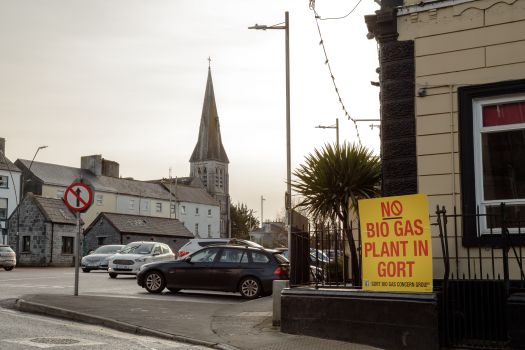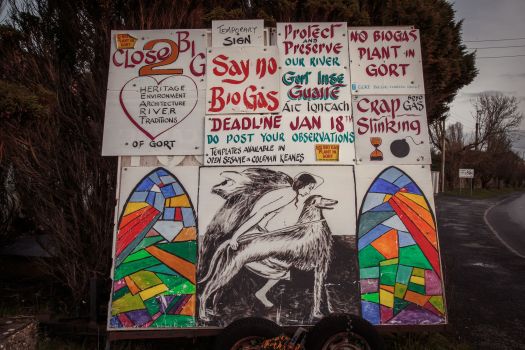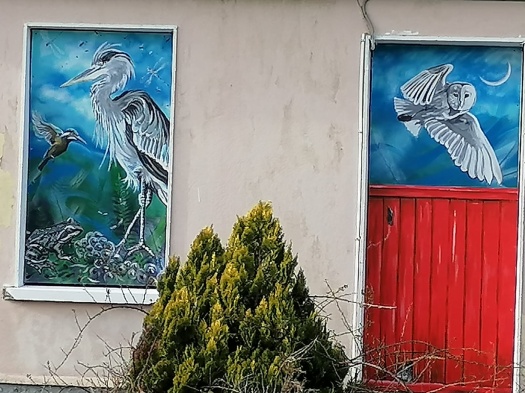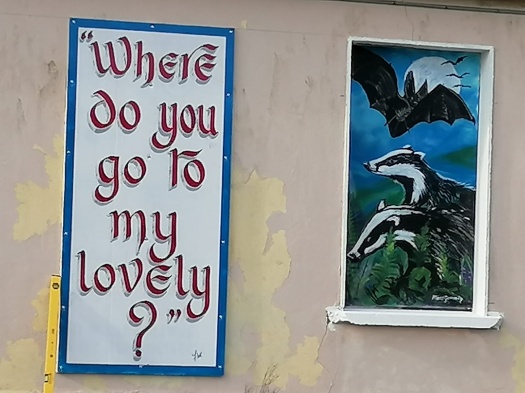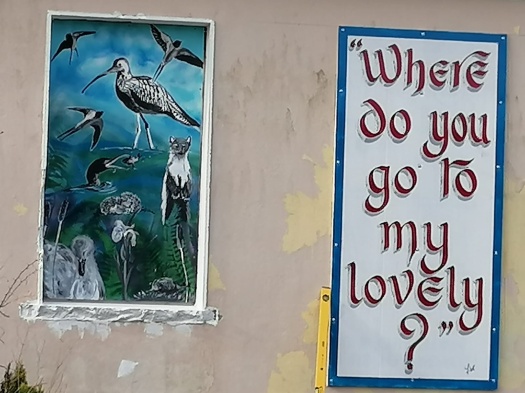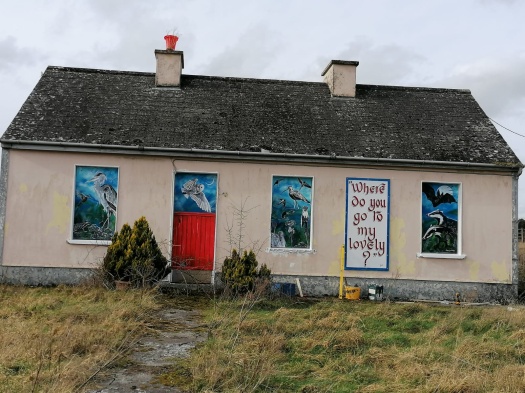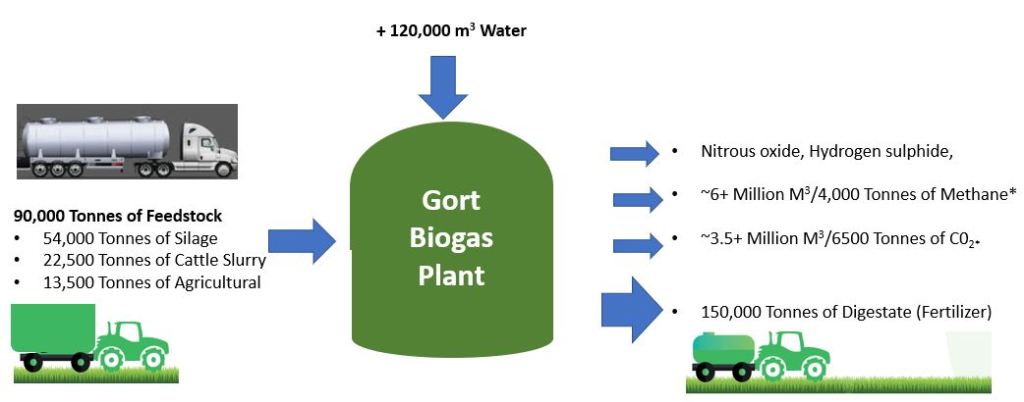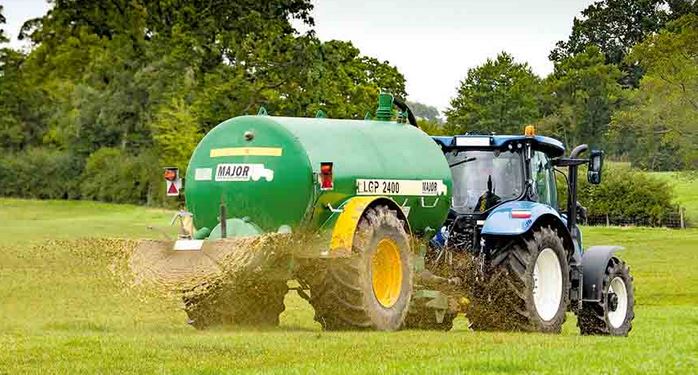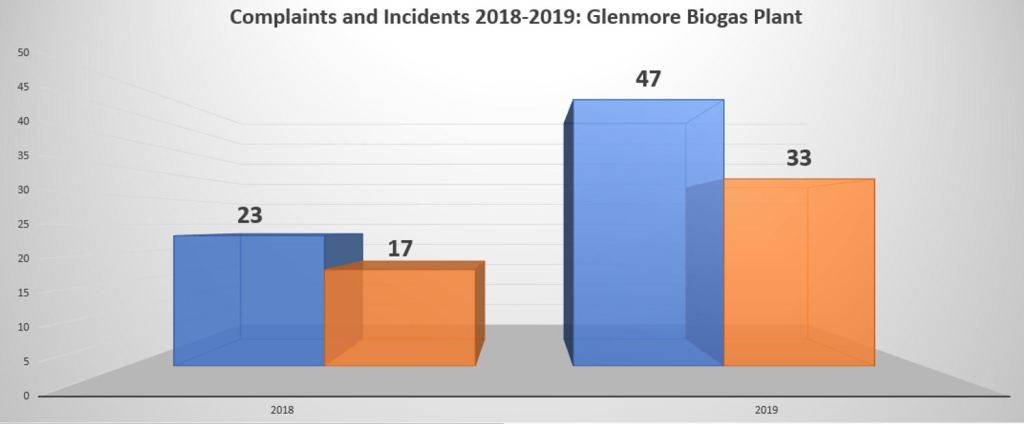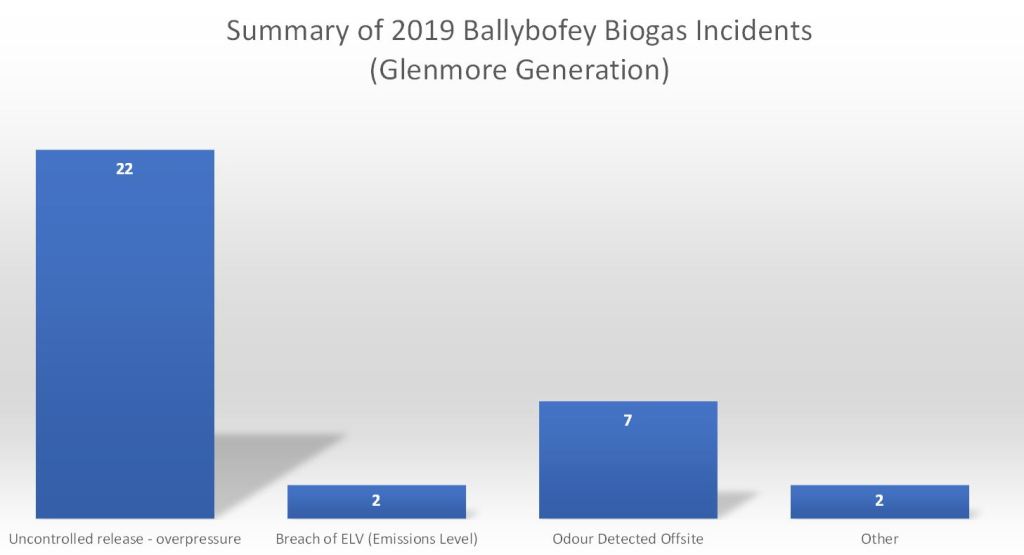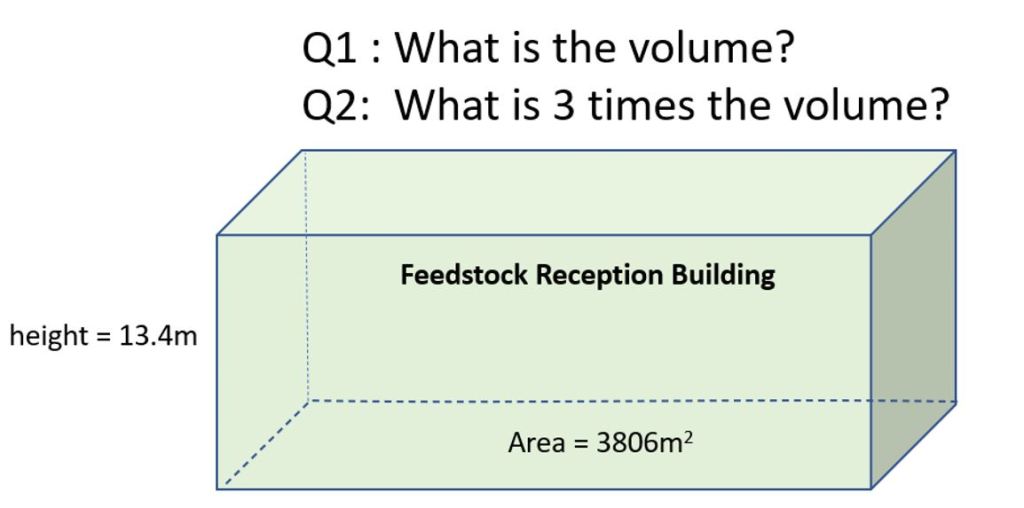The Gort Biogas saga, now in its 6th year, recently saw An Bord Pleanála (ABP) concede to a legal case brought by the Gort Biogas Concerns Group in the High-court. The developers, Sustainable Bioenergy Limited, are now considering requesting a remittal, which will effectively cause a restart of the process with APB, bringing the saga back to where it was in February, 2020. Another inspector will be assigned, another report produced, and another decision made.
Rather than wait at the behest of Sustainable Bioenergy Limited, the Gort Biogas Concerns Group has taken the time to take a deeper dive into the operations of the developers, consultants and operators. Here is what we have found….
So who are the developers ?
Sustainable Bio-energy Limited is the name of the developer for the Biogas Plant in Gort and they are based in Donegal. They are a subsidiary of Connective Energy Holdings Limited, who also own the Glenmore Generation plant in Ballybofey, Co.Donegal. We explored the backstory of the Glenmore facility in an earlier post (the Brimstone cowboys) and it makes for some concerning reading.
The Environmental (EIAR) reports on the Gort Biogas and Glenmore Generation plants are typically prepared by Halston, a project management company offering planning and environmental impact assessment services.
Throughout our six-year campaign, the Gort Biogas Concerns Group has reached out to the Sustainable Bio-energy to enter into dialog, but to no avail, they prefer to remain faceless and in the shadows.
Explosive Negligence
In October 2023, lightning struck a Biogas plant in Oxfordshire, UK, resulting in a huge explosion and resulting fire at the site.
Figure 1. Explosion of Biogas storage tanks due to a lightning strike at a Biogas plant in Oxfordshire, UK. October 2023.
The strike caused three of the four biogas storage tanks to explode. This required a massive response from the emergency services including, six fire engines, four ambulances and 40 firefighters to bring the blaze under control. Raw biogas, held in storage silos, wasn’t the only explosive material on site, as many Biogas plants also store processed Biogas (Biomethane) in compressed and highly explosive cylinders. Luckily no one was injured at this plant due to its remote location.
If this is the type of explosion that three tanks can produce, then what would be the potential for a plant with several times the volume? This is the size of the proposed Gort Biogas plant. With the closest home just 100m away, and the nearest housing estate just 200m away a blast at a plant of this magnitude would be catastrophic. How many fire engines and firefighters would be needed to bring something like this under control? Does Gort, or even County Galway or Clare have the emergency capacity for such a response?
Emergency plans for explosive sites are governed by Irish/European law under what is called COMAH (Control of Major Accident Hazards). Through the Environmental Impact Assessment Report (EIAR), such potential hazards are identified and addressed as a planning requirement. COMAH regulations require the company and consultants to undertake a full analysis to understand the health and safety concerns of the plant, adopt monitoring programs during operations and formulate emergency response plans including liaison with fire authorities and the Health and Safety Authority (HSA).
Biogas wasn’t considered explosive by planning consultant
As part of our analysis we looked into how Halston, the company who carried out the EIAR for the Gort plant, approached the COMAH regulation. The EIAR report concluded that they, in fact, did not consider the raw Biogas in the 12 tanks (digesters/storage) as an explosive substance and the proposed Biogas plant was therefore below the thresholds required under COMAH. Essentially, concluding that the facility was exempt from these regulations.
When you consider what happened in Oxfordshire , how could any diligent planning consultant conclude that Biogas is not a hazardous/ explosive substance and therefore to be exempt from a regulation designed specifically to mitigate against such incidents?
ABP excuses planning consultant
This was of course a huge concern for our community, and we brought this to the attention of An Bord Pleanála as part of our submission report.
The response from the ABP inspector was unbelievable. He excused the total omission of the Biogas as a hazardous substance by the developer. Then, correctly considering the Biogas as hazardous substance, the inspector did his own calculations and concluded, in agreement with the Halston EIAR report, that COMAH regulations didn’t apply to the Gort plant.
The Gort Biogas Concerns Group conducted its own analysis of and found that the ABP inspectors’ assumptions and calculations were not consistent with the regulations and that the Gort plant was well within the threshold. Not satisfied, we sought clarification from expert industry consultants in Ireland in preparation for our Judicial Review. Unfortunately, those with expertise in COMAH in Ireland were unwilling to engage with us, so we had to seek expertise in the UK. We engaged the services of experts who reviewed the plans and concluded that the site was indeed well within the COMAH threshold. In fact, due to its size, the development was almost twice the threshold where COMAH regulations are a legal requirement.
To fully inform our argument, we asked the consultant to review the APB inspector’s COMAH calculations. The consultant highlighted six serious errors made by the APB inspector. This became part of our legal case which APB had recently conceded.
Gort Bites Back
This incorrect COMAH assessment remains a key point in our campaign. The point that ABP conceded the case does not change the fact that without the proper assessment, this development would have proceeded unchecked. Placing a facility with potentially catastrophic potential in close proximity to residential areas, and with no incident response plan in place.
This warranted further action.
Planned developments in explosive breach
As planned Gort Biogas development by Sustainable Bio-energy Limited is in breach of the COMAH regulation in regards to the handling and storage of explosive gases, the Gort Biogas Concerns Group contacted the HSA in March with this information. This was an important step, as planning at the site remains active until ABP amends the order.
We contacted another group, faced with a similar plight as Gort, in Swinford, Co. Mayo, and let them know our findings. Through their own research, they too have demonstrated that their planning application is also in breach of the COMAH regulation. Another potential time bomb.
The fact that the Gort planning application passed through an environmental planning consultant and the ABP inspector, and both concluded, incorrectly, that the COMAH regulation did not apply, raises some serious questions about the overall planning process in regards to Anaerobic digestors – Ciaran O’ Donnell, Gort Biogas Concerns Group
Operational development in explosive breach
With two planned Biogas developments in breach of COMAH, and the potential for many more under the Governments Biomethane Strategy looming, we decided to look at an operational Biogas plant: Glenmore Generation Limited in Donegal, a subsidiary of Connective Energy Holdings Limited, and a sister company of Sustainable Bio-energy Limited, of the Gort Biogas development.
Here we conducted the same calculations of the COMAH requirements as we did in Gort but at the sister plant; Glenmore Generation Limited in Donegal, and found that they also appear to be in breach of these very same regulations.
Our research shows that Halston was again in charge of preparing the EIAR for Glenmore Generation Limited (Donegal), as it was for Sustainable Bio-energy Limited (Gort).
We therefore made contact with the HSA in March and reported the Glenmore Generation Limited Biogas plant as potentially being in breach of the COMAH regulations.
Operational development in planning breach
While researching the Glenmore Generation Limited Biogas plant, we reviewed the Donegal County Councils planning conditions for this facility. A key condition of planning permission was that no more than 20 tonnes of biogas (including biogas in the digesters and compressed biomethane) was to be stored onsite.
The developer indicated that they would comply as they only planned to store the compressed biomethane in 2 storage tank modules.
Last year, Glenmore Generation released a promotional Youtube video called ‘Behind the Scenes on our Biogas Operation’. From this clip, it is clearly evident that there are not two but six storage modules on site (Figure 2), enabling three times the capacity of their current planning restrictions.
Figure 2. Six compressed gas storage tanks at the Glenmore Generation limited. (Source: Youtube promotional video: ‘Behind the Scenes on our Biogas Operation’).
The Gort Biogas Concerns Group contacted Donegal County Council in March and submitted an enforcement complaint as this storage is contrary to planning applications at the Glenmore plant.
If people are to embrace this technology, then they need to trust the process. People need the reassurance that the decision making and planning process has been conducted thoroughly following environmental law and planning regulations – Ciaran O’ Donnell
Further investigations
From our investigation, we have identified serious issues within both planned and operational Biogas plants. This begs the question; how many of the current operational Biogas plants on the Island of Ireland are in breach of this and other regulations? With the Governments drive for a further 200 plants, what else will emerge?
This investigation highlights the cavalier culture of developers, consultants and operators to enable developments, come what may, in pursuit of profit. Glenmore Generation Biogas is not adhering to Irish and European COMAH regulations for health and safety, and is potentially storing three times more compressed gas than it was regulated to do so. This is not about planning though; this is about the health and safety of the people working on the site and the people in the surrounding community.
Donegal has already suffered a horrific gas explosion in Creeslough in October 2022, so Donegal County Council and the HSA will likely be hyper-vigilant to this blatant disregard of health and safety regulation.
It is clear that, for people to have confidence in this technology, then they need to trust it. For new planned Biogas plants, the emphasis is on An Bord Pleanála and local planning authorities and the HSA to ensure safety regulations are adhered to, and planning law followed.
Is it time for a full health and safety review of all current operational Biogas plants in Ireland ? Would it be prudent to establish government regulation and not guidelines for all new and existing anaerobic digestors as part of the Biomethane strategy ? We certainly think so.
We look forward to a timely response from Donegal County Council and the HSA in regards to our submissions.
The Gort Biogas Concerns Group has been consistent throughout; the use of anaerobic digestion can help to reduce our reliance on fossil gas, when sized and scaled appropriately to the needs of the local community. Putting the needs of communities ahead of industrialisation and profits, and ensuring the safety of people and the environment is paramount.
David Murray, Gort Biogas Concerns Group


